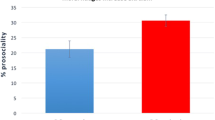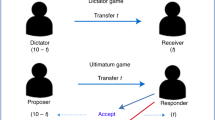Abstract
The law of supply is a fundamental principle of economics and states that any increase in price will increase the quantity supplied. In the case of prosocial behaviour, however, increasing rewards have reduced supply, posing a challenge to standard economic theory. Attempts to study such ‘crowding-out’ have been limited by their small scale and the inherent difficulties posed by calibration of experimental tests. We analyse a large-scale natural experiment in the environmental domain consisting of 20,370 independent observations derived from aggregation of approximately 27 million individual decisions. We find that aggregate supply of prosocial behaviour is ‘s-shaped’, demonstrating how attempts to increase prosocial behaviour using monetary rewards can be counter-productive. Our study shows that results derived from a small set of data points collected from an underlying s-shaped data-generating process are vulnerable to misinterpretation, and that proxy measures of intrinsic motivation ought to be collected to ensure theoretical advance.
This is a preview of subscription content, access via your institution
Access options
Access Nature and 54 other Nature Portfolio journals
Get Nature+, our best-value online-access subscription
$29.99 / 30 days
cancel any time
Subscribe to this journal
Receive 12 digital issues and online access to articles
$119.00 per year
only $9.92 per issue
Buy this article
- Purchase on Springer Link
- Instant access to full article PDF
Prices may be subject to local taxes which are calculated during checkout



Similar content being viewed by others
Data availability
The data that support the findings of this study are available for replication from the corresponding author on request. The data cannot be made publicly available due to property rights held by COOP and Statistics Sweden. Source data are provided with this paper.
Code availability
Custom code that supports the findings of this study is available from the corresponding author on request.
References
Dwenger, N., Kleven, H., Rasul, I. & Rincke, J. Extrinsic and intrinsic motivations for tax compliance: evidence from a field experiment in Germany. Am. Econ. J. Econ. Policy 8, 203–232 (2016).
Fehr, E. & Gächter, S. Do Incentive Contracts Undermine Voluntary Cooperation? Zurich IEER Working Paper No. 34 https://doi.org/10.2139/ssrn.313028 (2002).
Kolm, S. C. in Handbook of the Economics of Giving, Altruism and Reciprocity (eds Kolm, S. C. & Mercier-Ythier, J.) 1–122 (North-Holland, 2006).
Meier, S. in Economics and Psychology: A Promising New Cross-Disciplinary Field (eds Frey, B. S. & Stutzer, A.) 51−88 (MIT Press, 2007).
Gneezy, U., Meier, S. & Rey-Biel, P. When and why incentives (don’t) work to modify behavior. J. Econ. Perspect. 25, 191–210 (2011).
United Nations Development Programme. Human Development Report 2006 (Palgrave Macmillan, 2006).
World Health Organization. WHO Global Strategy for Containment of Antimicrobial Resistance (World Health Organization, 2001).
Ostrom, E. Governing the Commons (Cambridge Univ. Press, 2015).
Hardin, G. The tragedy of the commons. Science 162, 1243–1248 (1968).
Nyborg, K. et al. Social norms as solutions. Science 354, 42–43 (2016).
Frey, B. S. Not Just For The Money: An Economic Theory of Motivation (Edward Elgar, 1997).
Falk, A. & Kosfeld, M. The hidden costs of control. Am. Econ. Rev. 96, 1611–1630 (2006).
Bénabou, R. & Tirole, J. Intrinsic and extrinsic motivation. Rev. Econ. Stud. 70, 489–520 (2003).
Bowles, S. & Polania-Reyes, S. Economic incentives and social preferences: substitutes or complements? J. Econ. Lit. 50, 368–425 (2012).
Gneezy, U. & Rustichini, A. A fine is a price. J. Leg. Stud. 29, 1–17 (2000).
Titmuss, R. The Gift Relationship (reissue): From Human Blood to Social Policy (Policy Press, 2018).
Mellström, C. & Johannesson, M. Crowding out in blood donation: was Titmuss right? J. Eur. Econ. Assoc. 6, 845–863 (2008).
Holmås, T. H., Kjerstad, E., Lurås, H. & Straume, O. R. Does monetary punishment crowd out pro-social motivation? A natural experiment on hospital length of stay. J. Econ. Behav. Organ. 75, 261–267 (2010).
Fehr, E. & Rockenbach, B. Detrimental effects of sanctions on human altruism. Nature 422, 137–140 (2003).
Dickinson, D. & Villeval, M. C. Does monitoring decrease work effort?: The complementarity between agency and crowding-out theories. Games Econ. Behav. 63, 56–76 (2008).
Bewley, T. F. Why Wages Don’t Fall During a Recession (Harvard Univ. Press, 2009).
Li, J., Xiao, E., Houser, D. & Montague, P. R. Neural responses to sanction threats in two-party exchanges. Proc. Natl Acad. Sci. USA 106, 16835–16840 (2009).
Murayama, K., Matsumoto, M., Izuma, K. & Matsumoto, K. Neural basis of the undermining effect of monetary reward on intrinsic motivation. Proc. Natl Acad. Sci. USA 107, 20911–20916 (2010).
Goette, L. & Stutzer, A. Blood donations and incentives: evidence from a field experiment. J. Econ. Behav. Organ. 170, 52–74 (2020).
Lacetera, N., Macis, M. & Slonim, R. Will there be blood? Incentives and displacement effects in pro-social behavior. Am. Econ. J. Econ. Policy 4, 186–223 (2012).
Iajya, V., Lacetera, N., Macis, M. & Slonim, R. The effects of information, social and financial incentives on voluntary undirected blood donations: evidence from a field experiment in Argentina. Soc. Sci. Med. 98, 214–223 (2013).
Rommel, J., Buttmann, V., Liebig, G., Schönwetter, S. & Svart-Gröger, V. Motivation crowding theory and pro-environmental behavior: experimental evidence. Econ. Lett. 129, 42–44 (2015).
Harrison, G. W. & List, J. A. Field experiments. J. Econ. Lit. 42, 1009–1055 (2004).
Frey, B. S. A constitution for knaves crowds out civic virtues. Econ. J. 107, 1043–1053 (1997).
Deci, E. L., Koestner, R. & Ryan, R. M. A meta-analytic review of experiments examining the effects of extrinsic rewards on intrinsic motivation. Psychol. Bull. 125, 627–668 (1999).
Gneezy, U. & Rustichini, A. Pay enough or don’t pay at all. Q. J. Econ. 115, 791–810 (2000).
Deaton, A. & Cartwright, N. Understanding and misunderstanding randomized controlled trials. Soc. Sci. Med. 210, 2–21 (2018).
Open Science Collaboration. Estimating the reproducibility of psychological science. Science 349, aac4716 (2015).
Meier, S. Do subsidies increase charitable giving in the long run? Matching donations in a field experiment. J. Eur. Econ. Assoc. 5, 1203–1222 (2007).
Bandura, A. in Handbook of Moral Behavior and Development: Volume 1 (eds Kurtines, W. M. et al.) 69–128 (Psychology Press, 2014).
Cárdenas, J. C., Stranlund, J. & Willis, C. Local environmental control and institutional crowding-out. World Dev. 28, 1719–1733 (2000).
Pettersson, G. Miljöstatistik (Skill, 2012).
Mas-Colell, A. Whinston, M. D. & Green, J. R. Microeconomic Theory (Oxford Univ. Press, 1995).
Bénabou, R. & Tirole, J. Incentives and prosocial behavior. Am. Econ. Rev. 96, 1652–1678 (2006).
Beretti, A., Figuieres, C. & Grolleau, G. How to turn crowding-out into crowding-in? An innovative instrument and some law-related examples. Eur. J. Law Econ. 48, 417–438 (2019).
Müller, S. & Rau, H. A. Motivational crowding out effects in charitable giving: experimental evidence. J. Econ. Psychol. 76, 102210 (2020).
Frey, B. S. & Jegen, R. Motivation crowding theory. J. Econ. Surv. 15, 589–611 (2001).
Richard, M. & Deci, E. Intrinsic Motivation and Self-Determination in Human Behavior (Springer, 1985).
Rode, J., Gómez-Baggethun, E. & Krause, T. Motivation crowding by economic incentives in conservation policy: a review of the empirical evidence. Ecol. Econ. 117, 270–282 (2015).
Bohnet, I. & Baytelman, Y. Institutions and trust: implications for preferences, beliefs and behavior. Rationality Soc. 19, 99–135 (2007).
Kessler, E. Behavioural Economics of Performance Incentives (Univ. Nottingham, 2008).
Carpenter, J. & Myers, C. K. Why volunteer? Evidence on the role of altruism, image, and incentives. J. Public Econ. 94, 911–920 (2010).
Henrich, J., Heine, S. & Norenzayan, A. The weirdest people in the world? Behav. Brain Sci. 33, 61–83 (2010).
Valmyndigheten. Valresultat 2010 https://www.val.se/valresultat/riksdag-region-och-kommun/2010/valresultat.html (2019).
University of Gothenburg, SOM Institute. The National SOM Survey 2010, version 1.0 (Swedish National Data Service, 2012); https://doi.org/10.5878/002316
Cameron, A. C. & Miller, D. L. A practitioner’s guide to cluster-robust inference. J. Hum. Resour. 50, 317–372 (2015).
Wooldridge, J. M. Econometric Analysis of Cross Section and Panel Data (MIT Press, 2002).
Acknowledgements
Financial support from the Adlerbertska Foundation (Adlerbertska Forskningsstiftelsen) (C.E.W.), and the Swedish Research Council (Vetenskapsrådet, 2018-04793) (C.E.W., P.M.) is gratefully acknowledged. The funders had no role in study design, data collection and analysis, decision to publish or preparation of the manuscript. Access to data was generously provided by P. Rosengreen (COOP), K. Lundell (Returpack), A. Jensen (Kooperation utan gränser) and E. Ebbeson (Returpack). We thank participants at the Copenhagen Network for Experimental Economics (CNEE), the International Meeting on Experimental and Behavioural Economics (IMEBE), C. Akinci, E. Persson, H. Gutierrez Rufrancos and members of Stirling Behavioural Science Centre, especially P. Ebert, M. Moro and F. de Vries, for helpful comments. Views herein are exclusively those of the authors.
Author information
Authors and Affiliations
Contributions
C.E.W., M.K. and P.M. designed the research. C.E.W., M.K. and P.M. performed the research. C.E.W. and M.K. analysed the data. C.E.W. wrote the paper.
Corresponding author
Ethics declarations
Competing interests
The authors declare no competing interests.
Peer review
Peer review information
Nature Human Behaviour thanks Charles Figuières and the other, anonymous, reviewer(s) for their contribution to the peer review of this work.
Additional information
Publisher’s note Springer Nature remains neutral with regard to jurisdictional claims in published maps and institutional affiliations.
Extended data
Extended Data Fig. 1 Box plot of expected reward E[rt] by year.
The center line denotes the median; box limits denote first and third quartiles; whiskers denote the highest (lowest) value within 1.5x the interquartile range, measured from box limits; points denote outliers defined as observations larger (smaller) than 1.5x the interquartile range measured from box limits (n = 20,370).
Extended Data Fig. 2 Box plot of quantity of recycled cans by year.
The center line denotes the median; box limits denote first and third quartiles; whiskers denote the highest (lowest) value within 1.5x the interquartile range, measured from box limits; points denote outliers defined as observations larger (smaller) than 1.5x the interquartile range measured from box limits (n = 20,370).
Supplementary information
Supplementary Information
Robustness checks, Supplementary Fig. 1 and Tables 1 and 2.
Supplementary Data
Statistical results to support Supplementary Table 2.
Source data
Source Data Fig. 1
Statistical source data for Fig. 1.
Source Data Fig. 2
Statistical source data for Fig. 2.
Source Data Fig. 3
Statistical source data for Fig. 3.
Source Data Extended Data Fig. 1
Statistical source data for Extended Fig. 1.
Source Data Extended Data Fig. 2
Statistical source data for Extended Fig. 2.
Rights and permissions
About this article
Cite this article
Wollbrant, C.E., Knutsson, M. & Martinsson, P. Extrinsic rewards and crowding-out of prosocial behaviour. Nat Hum Behav 6, 774–781 (2022). https://doi.org/10.1038/s41562-022-01293-y
Received:
Accepted:
Published:
Issue Date:
DOI: https://doi.org/10.1038/s41562-022-01293-y
This article is cited by
-
Reward whistleblowers who expose environmental crimes
Nature Human Behaviour (2024)



